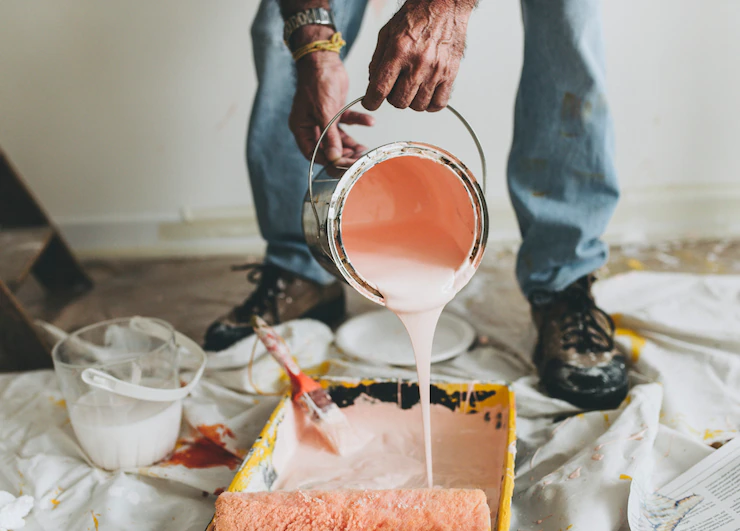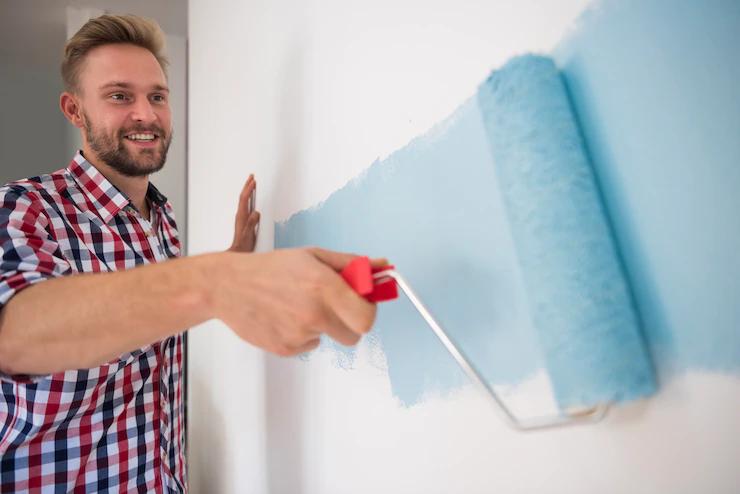Low VOC Paint: A Breath of Fresh Air for Your Interior

Paint is one of the harmful construction and design elements. It’s created with harmful chemicals that prolonged exposure may cause several health problems. As a solution, innovators have come up with a type of paint containing minimal amounts of toxic compounds.
Volatile organic compounds (VOC) are harmful gases released by specific solid or liquid particles. They are commonly found in construction materials and furnishings such as paint, paint thinner, insulation, adhesives, carpet, composite wood, and even cleaning products.
Since VOCs seem unavoidable, construction workers must wear personal protective equipment (PPE) to prevent adverse health effects.
Although not all VOCs cause severe health problems, limiting usage and taking safety precautions are ideal. One of the best solutions is only to use low VOC products.
Understanding VOCs
Indoor air quality is considered one of the most integral components, whether it is at home or the workplace. We spend most of our time indoors. Thus, it is crucial to ensure that we are breathing some healthy air at home, school, or even at our workplace.
One such pollutant is VOCs or the Volatile Organic Compounds. Here in this section, we will understand everything about the VOCs or the volatile organic compounds.
What is Low VOC Paint?
The Volatile Organic Compounds are mainly a whole group of compounds with high vapor pressure and low water solubility. Simply put, we can say that substances will not bind to themselves that easily, nor are they going to dissolve in water.
VOCs emit gas from products and processes such as building materials, custodial products, and even maintenance equipment.
One thing that you must know is that the term VOC does not refer to one particular substance. It refers to a whole group of substances that specifically exhibit all kinds of chemical properties. You may find thousands of such substances that you may find buildings such as:
| Substances | Found in |
|---|---|
| Benzene | Tobacco, Deodorizers, Furniture polish, Air fresheners, and Tobacco smoke |
| Ethylene glycol | Cleaning agents, Personal care products, Perfumes |
| Formaldehyde | Disinfectants, Furniture upholstery, Carpets, Plywood |
| Toluene | Paint, Metal cleaners, Adhesives |
| Tetrachloroethylene | Dry cleaning, Paint strippersSolvents, |
| Methylene chloride | Spot removers,Dry-cleaned clothes, Air conditioner refrigerantCommercial solvents, Fabric cleaners |
Now low VOC paints are mainly considered as the safe material to use indoors, which can help to improve the overall air quality. These paints have a lower odor than the usual oil-based ones. Now you can call a paint low VOc if it has:
- Fewer than a total of 50 grams of VOCs per liter when it comes to flat or matte paints.
- Fewer than 100 grams of VOCs per liter for the satin, semi-loss paints, and other non-flat paints.
Benefits of Using Low VOC Paint
The Low VOC paints come with various advantages, which include:
- The Low VOC paints are made out of only a few volatile organic compounds. Thus, it it very safe and clean to use.
- Low-VOC paints produce less pollution and improve overall air quality.
- The Low VOC paints are very easy to clean. You can just use soap and water to clean any dirt or dust from the wall surface.
- When it comes to long-lasting paint and durability, you can rely on the low-VOC paint. These paints maintain their color for a long period of time.
- Another major benefit of low VOC paint is that it dries really fast. On top of that, these paints are odorless.
Types of Low VOC Paint
Other than the low VOC paint, there is another type of VOC paint that helps with less emission, the Zero VOC paint. I will explain about these two paints in the following:
Zero VOC paint: These paint types have almost no detectable range of VOCs. This is exactly what makes the paint environment- friendly. These Zero VOC paints typically have low odor and are water-based.
Low VOC Paints: On the other hand, the low VOC paints have a lower VOC level than the traditional paints. However, these paints still contain an number of VOCs. Like Zero VOC paint, these paints are water-based and have a low odor.
Now, within these two categories, you will find different types of low VOC paints, which are totally based on their finishing:
| Matte | The matte finish mainly has a flat appearance, It can be the best choice for you if you are trying to hide the imperfections on walls. |
| Satin | The satin has a slightly sheen finish. It is also more durable than matte paints. You can use satin paint in high-traffic indoor spaces. |
| Semi-gloss | The semi-gloss also has a moderate sheen. It is more durable than the satin paints. You can use the semi-gloss paint on trims and doors. |
| Gloss | Lastly, the gloss finish provides a sheen finish. This type has the most durable finish of all. You can use this for trim and doors of the high traffic areas. |
Low VOC Paint Is The Better Alternative
Low VOC paints are some of the safest options when painting your home, especially the interior. Oil-based and solvent-based paints often contain high VOC, causing severe odor that may cause throat and sinus irritation.
Therefore, switching to water-based paints with low VOC is healthier for your home construction and furnishing.
Here are some notable features of low VOC paints that will ease your worries during home renovation projects:
1. An Eco-Friendly Paint

Low VOC paints are eco-friendly. They release the least amount of fumes, minimizing their effect on the environment. You can also prevent air pollution common in home renovation or construction.
One of the most harmful VOCs found in paint is formaldehyde. Aside from its effects on human health, releasing it into the environment can also harm wildlife.
It may cause diseases and reduce animals’ lifespan. Avoiding products containing this compound can prevent some environmental problems.
If you’re looking for Premium Interior Paints for your home improvement project, choosing low VOC paints is best. You don’t have to worry about diminishing the indoor air quality as you paint. However, it’s still best to open the windows to keep the room well-ventilated
2. A Safer Paint Alternative

Low VOC paints are a safer paint alternative. Wearing an N95 mask is often enough to protect you from airborne particles. The smell is not too strong, and the fumes are much less than oil and solvent-based paints containing high VOC.
Searching for the safest paint brands is essential for every home project. Aside from avoiding VOCs, you may also look out for other harmful contents such as phthalates, glycol ethers, titanium dioxide, zinc oxide, lithopone, and ammonia.
Although it’s challenging to find products that don’t contain these toxic ingredients, there are eco-friendly paint brands you can rely on.
Low VOC paint is an excellent choice if you’re painting your home interior as a DIY project. Since you’ll be painting in an enclosed space, choosing a paint type that releases less odor is imperative. This way, you can reduce the concentration of harmful fumes within the room
Switching to low VOC paints for your home and other furnishing projects can be a lifesaver. You can avoid short-term effects like throat and nose irritation and long-term consequences like lung problems and cancer.
Check Also: Creative Interior Paint Design Ideas
3. A Fast-Drying Paint

Most low VOC paints are water-based. This type of paint is generally fast-drying, perfect for DIY home projects. When the paint dries fast, you can quickly move on to the next step of furnishing.
High VOC paints like oil and solvent-based enamels may take up to 24 hours to dry. As the paint dries, it releases fumes that may irritate.
Even when it’s completely dried, you can still smell some odor that may cause dizziness and nausea. If you’ve used high VOC paint in a room, you can’t use it for at least two weeks due to the fumes.
On the other hand, low VOC paints are water-based and can dry as fast as 6 hours. This timeframe for drying is excellent for painting walls that require multiple coats.
Most paint types may still have a slight odor, but they don’t cause any breathing problems, especially if you’re wearing a face mask.
The fast-drying feature of low VOC paints is perfect for busy homes. After painting a room with low VOC paint, you can use it after two to three days. If the room is well-ventilated, the fumes will all be gone.
4. A Durable Exterior And Interior Paint

Low VOC paints are also known for their durability and strong adherence to various surfaces. Despite being water-based, this type of paint can be water-resistant when it becomes dry, making it suitable even for exterior use.
Water-based paints are recommended for home exterior sidings, even for locations with harsh climates.
If the surfaces are properly primed, low-VOC paints can withstand rain damage. You can now protect your home without compromising health and environmental safety.
Moreover, low VOC water-based paints are also ideal for interior use. Without worrying about peeling and cracks, you may use them in moisture-prone areas like bathrooms and kitchens. As long as you have prepared the surface as recommended, the paint will last.
Choosing the Right Low VOC Paint
When you are choosing the right kind of low VOC paint, it is necessary to consider the following factors:
- VOC level: Always remember that the lower the VOC level, the better it is for the air quality.
- Finish: Try to choose a kind of finish that is highly appropriate for any surface that you are painting.
- Color: Darkest paint colors tend to have a high level of VOC. Thus, you must choose the color wisely. Check the VOC level before you purchase.
- Brand: Choose the brands that are committed to producing lower VOC paints tahn the others.
If you can choose low VOC paints, it can vastly help you to improve your indoor air quality and reduce the impact on the environment.
Application and Usage Tips
Here are some tips on how to use low VOC paints:
- Firstly, you must stir the paint well before you start the process.
- You can use synthetic rollers. It can help you to create a smooth and uniform appearance.
- Keep replacing the worn synthetic rollers in order to achieve consistency, appearance, and thickness.
- Once you have applied 2 to 3 drops of paint, backroll the wet paint immediately in order to get that smooth finish.
- You can use natural bristles for the oil-based paints.
- The low VOC paint usually has a spread rate of around 16 square meters per liter. However, this coverage can be lower for rusty surfaces.
- At 25°C, you can touch dry the low VOC paints in 30 minutes and recoat the paint after 2 hours. However, in cooler or humid conditions, you must wait upto 4 hours before you recoat the paint.
- When it is warm and ry condition, a humidifier can help you to slow down the drying time of VOC paint.
Common Myths About Low VOC Paint
There are some common myths and misunderstandings about low VOC paints. Do not get fooled by these myths that can create a false statement about the low VOC. Here are the myths about low VOC non-toxic paints.
- Zero VOC paint is always the same. No, the zero VOC paint varies on the brands.
- Low VOC paint has a very limited color option. Well, there are like Benjamin Moore offers you a wide range of colors for low VOC paints.
- All VOCs cause harm. While it is true that most of the VOCs are harmful, there are some that are yet to be proven as harmful to death.
- If it is written low VOC, it means that it is safe. No! The low VOC means the level of VOC that is present in it is a bit lower.
Real-Life Examples and Success Stories
Consider this story of a local school. The authority decided to switch to low VOC paints for their classroom. Do you know what the result was? Well, as per the teachers and students, they were experiencing fewer allergic reactions and headaches.
This further led to a better learning experience. The issue of absenteeism was also solved.
Similarly, a manufacturing plant switched to eco-friendly coating and observed an employee boost on-site. It also helped to reduce overall ventilation costs.
Conclusion
Low VOC paints are a sustainable choice in home renovations and construction. They’re safe to use and highly durable. Using low VOC paint for your next home improvement project is a smart choice to prevent health problems caused by prolonged exposure to harmful chemicals.
Read Also:











Leave A Reply